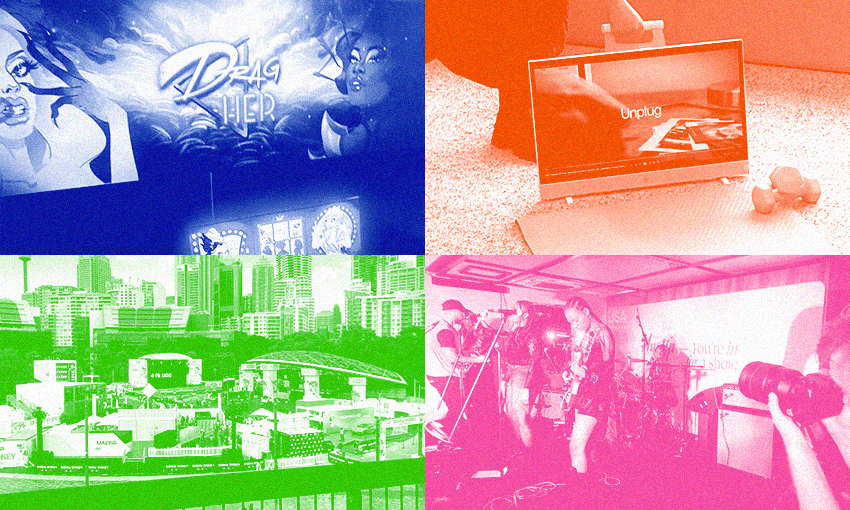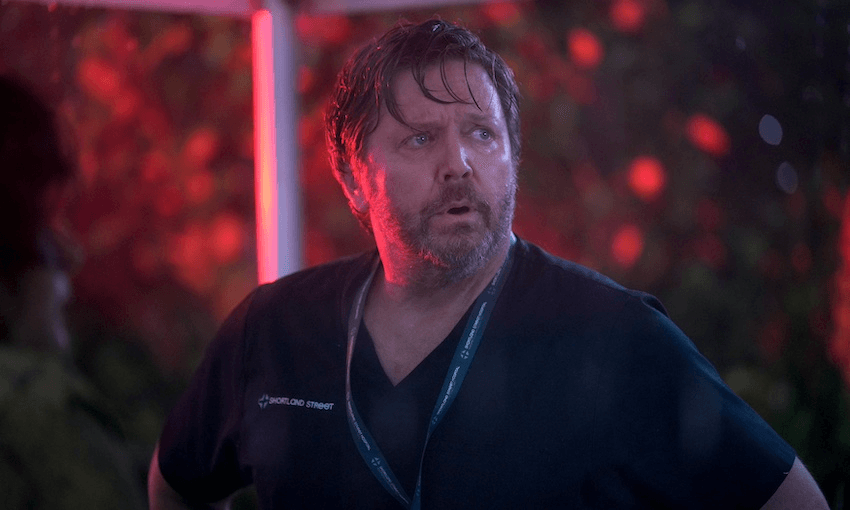Sam Brooks spends a strange three days at the Australian iteration of the popular conference/festival.
“Isn’t that in Texas?” asked several people when I told them I was going to South by Southwest (aka SXSW or, mortifyingly, “South by” out loud). I explained that I was not going to Austin, but instead to a satellite iteration of SXSW taking place in Sydney.
“Isn’t that a film festival?” others asked. My answer to that was “… kind of.” While the headlines that the original SXSW in Austin, Texas, tends to generate are about the buzzy film and TV premieres they host, the festival is actually an amorphous conglomeration of film, interactive, media and conferences with a decidedly techy, futurist bent.
I did not end up seeing any films at SXSW (although I would’ve loved to have a crack at Faraway Downs, the limited series version of Baz Luhrmann’s mildly panned 2008 film Australia). I did not even attend any of the buzziest talks, which included the likes of Nicole Kidman, Chance the Rapper, Naomi Watts and Charlie Brooker talking about a variety of topics.
I did end up seeing some bleak talks, as well as some interesting ones. I played a game. I saw two gigs by New Zealand musicians and one by an excellent Austin band (We Don’t Ride Llamas, look them up). I saw some pretty cool – and really expensive – tech products.
This is one person’s experience of SXSW Sydney.
Tuesday
As I walked to the convention centre, I passed Primeville – an immersive pop-up experience for which a venue has been transformed into a “small town” inspired by Prime Video’s most beloved shows. There was a short line outside, which I did not join, because I doubted Fleabag would be one of the shows represented in Primeville.
The first talk I went to was a deceptively named one about how creatives can use data in their work. If you think that is about how creatives can use data to inform which audiences are engaging with their work, you would be like me, and therefore wrong. If you think that it is about how data transfer software like WeTransfer, and internet infrastructure like fibre can enable the literal movement of data across the world between creatives, you are correct. Please contact me so I can learn your skills of deduction.
In this session, the word “content” was dropped 61 times. At no point did anybody mention a specific piece of art, or creator (I consider a mention of Tom Cruise pretty borderline). This turned out to be a pretty bleak omen of a few of the sessions I would attend across the next few days. An essay by Bill Gates back in 1996 stated that “content is king”. In 2023? Content is peasant.
I followed this up with easily my most anticipated talk of the three days: Kip Williams talking about the development of Sydney-born, West End-bound hit The Picture of Dorian Gray, which was a revolutionary step forward in the use of live camera feeds in theatrical works. It was the ideal of what a discussion like this should be like, hosted by theatrical titan Michael Cassels. They touched on what an audience will and won’t accept in regards to breaking genre, the insane technology required to blend between pre-recorded footage and live filming, and just how hard it is for a solo performer to do a two-hour solo show in which they play nearly 30 characters.
I thought it was setting me up for a bracing, enlivening week of discussions of how art and tech can blend, and uplift each other. How wrong Wednesday would prove me.
Wednesday
Wednesday morning saw us trekking to HP’s Sydney office to oversee the launch of two new products: the HP Spectre Fold (the world’s “thinnest and smallest 17-inch foldable PC”, which is… a lot of qualifiers) and HP Envy Move (the world’s “only moveable all-in-one PC”).
The demonstration of the former was actually pretty cool/terrifying, which is not an uncommon intersection when it comes to tech. It can turn into a desktop, laptop or tablet, includes a wireless charging keyboard and pen, a screen with IMax enhanced certification, and AI that does a wide range of things, including dimming the screen when you walk away, or when someone who isn’t you approaches the screen. I nodded my head throughout, and tried to hide my surprise at the $9,999 price tag. Maybe for my birthday.
The HP Envy Move, on the other hand, is essentially a large tablet with a handle and cute little feet that spiral out when you put it down. It was priced at a more reasonable $2,999, though I struggled to get past the intrusive thought of how easy it would be to accidentally break.
After the showcase, I walked past Primeville – the line was shorter this time – and tried to get into the Charlie Brooker talk, but failed, so I decided to sprint down the hall to instead attend a session on why creatives need to start thinking about space. The name of this session didn’t confuse me this time, I knew they were talking about the space that’s up there in the sky. It ended up being a pretty fascinating session, albeit slightly terrifying when the panel – all of whom work in the space space (yes, that is a phrase that people said with straight faces) – pointed out how much we all rely on satellites, and without space, so many things we take for granted, including the very internet you are reading this on, would falter.
The two panels that followed led me down a pretty bleak trajectory. The first being on HP’s research into the work relationship index, which is not about relationships at work, but relationships with work. Essentially, it revealed that people want a healthier relationship with work, and are willing to sacrifice higher pay for flexible hours, the ability to work remotely, and better workplaces. (From a certain lens, you could view this as justification to pay people less for better conditions, but that would be a very cynical place to view it from, wouldn’t it.)
The other, also hosted by HP, was how to embrace new technology responsibly, held on the expo floor that I truly did not know existed until this panel. If you’ve ever been to an expo, you’ve been to every expo. Smiling faces next to stands, advertising products and services that all start to blend into one another, hoping to be the next success story. If it proves anything, it proves that advertising is just as easy to ignore in person as it is online.
I came away from the panel, where people invested in tech perhaps unsurprisingly advocated for greater accessibility to tech, with one line echoing in my head: “We want to be seen as being ethical.” This was uttered, in earnestness, by one of the panellists, who is very senior at a tech company. Hey, don’t we all!
Thus far, the biggest commonality I noticed was that despite this being a tech expo, a lot of people seemed not to understand the very basic technical concept that one needs to talk into a microphone to be picked up by a microphone.
The other? All this tech, and we still cannot think of a better way to identify people for a conference than lanyards.
Thursday
On Thursday I was free as a bird to attend, or not attend, whatever I liked. After breakfast at my favourite chain – Pancakes on the Rocks, nowhere near The Rocks – I wandered 15 minutes down the road to check out the games side of SXSW. Three floors up in a hotel, a room packed full of PCs allowed people to play a wide range of indie games, including NZ’s own gaming success story Dredge.
I decided to sit down with Drag Her, which is basically what happens when you cross Street Fighter with RuPaul’s Drag Race. About two minutes into throwing makeup at Laganja Estranga while playing as Kimchi, someone came up to me and asked if she could take my photo. Drag Her is her friend’s game, and they’d be so stoked to see someone playing it. It was the best interaction I’d had in three days.
My last panel of my time at SXSW was guaranteed to be less bleak than the ones that I’d been to in the days before: “Death and Dying in Video Games.” In a little lecture theatre about 10 minutes from the main conference centre, I listened to academics and developers discuss a concept that had genuinely never crossed my mind before: the idea that video games are the one artform that lets us engage, and access, and wrangle with the concept of death. I left that session with my mind bigger, my heart lighter, and my soul a bit brighter.
I closed out my time at SXSW by supporting some locals. ASHY, a Christchurch-based popstar with a banger of an EP that came out this year brought the good vibes in a hotel lobby, while DARTZ absolutely rocked it for about 20 people at 5pm – a harder gig than it sounds. Both acts were absolutely great, but it did have me thinking: why were they there?
Recently, The Spinoff’s books editor Claire Mabey dropped the term “artwashing” into a conversation. Taking on the etymology of greenwashing, pinkwashing, et al – it basically means when a festival, a conference, an organisation uses art to cloak or cover up the true purpose, or to make itself seem cooler or more progressive than it actually is. Was it cool that SXSW was supporting these artists? Absolutely. Did they feel like a little bit of an afterthought? Also yes.
I walked past Primeville one last time before I left. There was no line, and now it was free for anybody to go in. You didn’t even need a lanyard.
The writer was hosted by HP for this experience.



